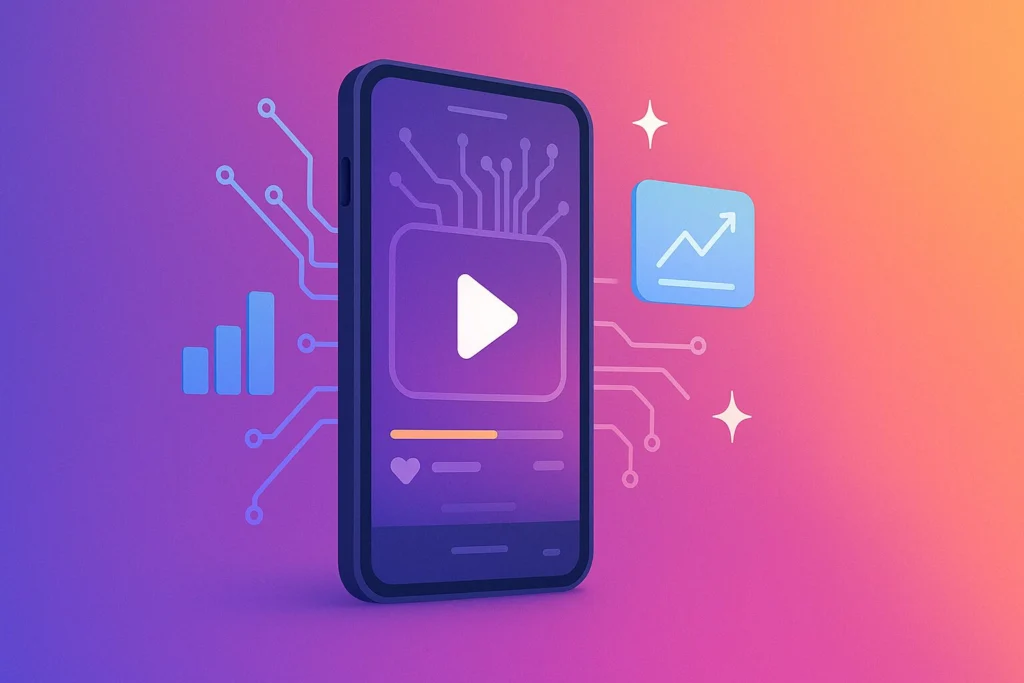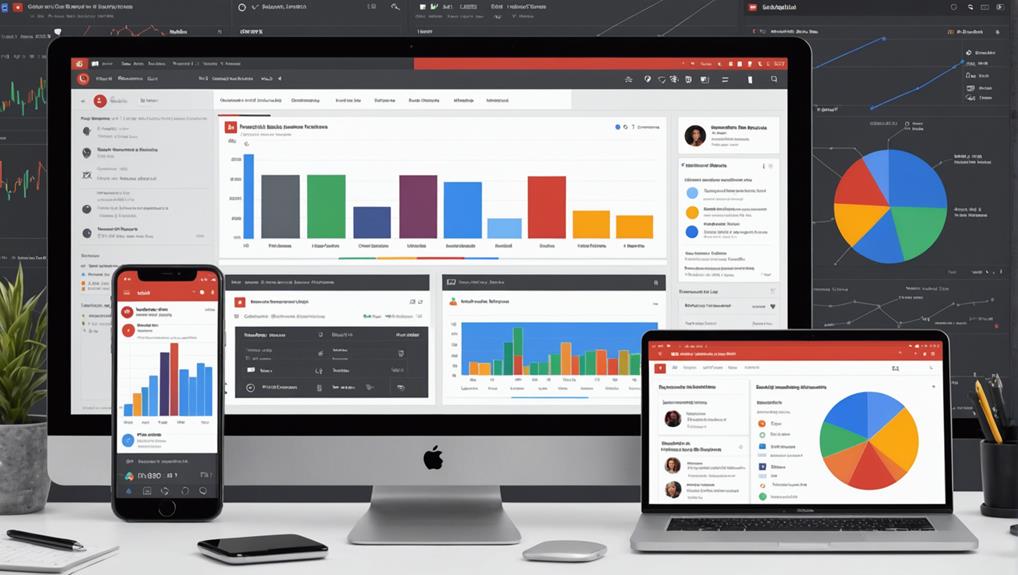Accessing a YouTube video transcript can be done directly on the platform or through transcription services. On a desktop, select the video, click “More,” and then “Show transcript.” Mobile users must tap the three dots beneath the video title to reveal this option. For better accuracy, automated tools such as Descript or Notta convert audio to text with high precision. Professional transcription services offer even greater accuracy, suitable for time-sensitive or meticulous projects. Understanding these options helps engage a wider audience, improves accessibility, and enhances content repurposing. Discover more insightful details on accessing and utilizing transcripts efficiently.
Key Takeaways
- Click “More” under the video title, then select “Show transcript” to display the text version on desktop.
- Open the YouTube app, tap “…” under the video title, and select “Show transcript” on mobile.
- Automated transcription tools like Descript convert YouTube audio into text with high accuracy and export options.
- Third-party services provide reliable transcription solutions with multiple language support and better clarity.
- YouTube’s auto-generated transcripts may contain errors, requiring manual editing for improved accuracy.
Importance of YouTube Transcripts
Although often overlooked, YouTube transcripts serve as an important tool in enhancing the accessibility and reach of video content. By providing text alternatives, they guarantee that deaf and hard-of-hearing individuals can access the same information as other viewers, broadening the audience base for creators.
The inclusion of YouTube transcripts greatly improves search engine optimization (SEO). By embedding relevant keywords, transcripts make videos more discoverable, thereby increasing viewership potential. This boost in discoverability is vital for creators aiming to expand their reach in a crowded digital landscape.
Furthermore, transcripts facilitate content repurposing, enabling creators to efficiently transform video material into blog posts, social media updates, and educational resources. This versatility not only maximizes the lifespan of the content but also enhances engagement by allowing audiences to interact with material in multiple formats.
Written content provided by transcripts allows viewers to scan for key points swiftly, improving comprehension and engagement with complex topics.
Additionally, multi-language support in transcripts can help reach non-English speaking audiences, fostering global engagement. This feature guarantees that creators can communicate their messages across linguistic barriers, thereby expanding their viewer base worldwide.
Essentially, YouTube transcripts are invaluable for enhancing engagement and accessibility.
Finding Transcripts on Desktop
Understanding how to access YouTube transcripts on desktop devices is fundamental for maximizing the benefits they offer regarding accessibility and engagement. To locate a transcript, begin by selecting the desired YouTube video. Underneath the video title, you will find a “More” option. Clicking this will expand the description, revealing the “Show transcript” button. Once clicked, the transcript appears alongside the video player, providing a thorough text version of the video content.
The transcript serves as a valuable resource, offering the spoken words in a written format. This can be especially beneficial for viewers who prefer reading or need to reference specific parts of the video. Users can easily navigate through the text using the provided timestamps, which allow quick access to different sections of the video.
Furthermore, if the video offers transcripts in multiple languages, a drop-down menu will enable users to select their preferred language.
To save the transcript for future use, one must manually copy and paste the text from the transcript box into a document. This process allows for further editing and formatting, ensuring that the information is readily accessible and organized according to individual needs.
Accessing Transcripts on Mobile
Maneuvering the YouTube app on a mobile device to access video transcripts is a straightforward process that enhances the user’s ability to engage with content on-the-go. To begin accessing transcripts on mobile, open the YouTube app and locate your desired video. Directly under the video title, tap the “…” more option to reveal additional details. Here, you will find the “Show transcript” option, which displays the text version of the video’s spoken content directly within the app. This feature allows users to follow along with the video content, providing timestamps that facilitate navigation to specific sections.
While accessing transcripts on mobile, it’s important to note that direct copying of text isn’t possible. Users may need to manually type any significant quotes or sections they wish to retain. For those preferring to read in a different language, the YouTube app provides flexibility. Tap the three vertical dots in the transcript view to select your preferred language if multiple options are available.
| Feature | Description | Action Required |
|---|---|---|
| Accessing transcripts | View spoken content as text | Tap “…” then “Show transcript” |
| Timestamps | Navigate to video sections | Automatic inclusion |
| Language Selection | Choose preferred transcript view | Use three vertical dots |
Using Automated Transcription Tools
In the domain of digital content consumption, automated transcription tools like Descript and Notta have emerged as invaluable resources for efficiently converting YouTube video audio into text. These tools offer high accuracy rates, often achieving around 98%, which guarantees reliable YouTube video transcripts. The convenience of importing YouTube links directly into these tools eliminates the need for manual audio recording, considerably accelerating the transcription process.
Automated transcription tools are equipped with features such as speaker identification and timestamp generation, enhancing the clarity and usability of the transcripts. These features allow users to easily follow along with the video content, making it simple to identify who is speaking and when.
Additionally, these tools enable users to export transcripts in various formats like TXT, DOCX, and SRT, facilitating content repurposing across different platforms.
Moreover, the use of automated transcription tools enhances accessibility by providing subtitles for individuals who are deaf or hard of hearing. This not only broadens audience reach but also boosts SEO by embedding relevant keywords within the transcript.
Benefits of Professional Transcription Services
Professional transcription services offer unparalleled accuracy and reliability, especially for projects where precision is non-negotiable. With high accuracy rates often exceeding 99%, services like Rev and GoTranscript guarantee reliable transcripts for critical applications. This exceptional precision is achieved through rigorous quality control measures, where skilled transcribers meticulously review content for grammar, spelling, and punctuation accuracy. Such attention to detail is invaluable in contexts such as legal proceedings or intricate interviews, where diverse audio qualities are common.
Moreover, professional transcription services provide a faster turnaround time, particularly beneficial for urgent projects that demand prompt delivery. Many services promise results within 24 hours, offering a significant advantage over other methods. Additionally, these services frequently include advanced features like timestamping and speaker identification. These enhancements not only improve transcript organization but also facilitate easy navigation and usability across various applications.
| Feature | Benefit | Application |
|---|---|---|
| High Accuracy Rates | Reliable Transcripts | Critical Projects |
| Quality Control Measures | Error-free Content | Legal, Corporate Documentation |
| Diverse Audio Handling | Precision in Complex Content | Interviews, Legal Proceedings |
| Faster Turnaround Time | Quick Delivery | Urgent Projects |
Ultimately, professional transcription services are indispensable for those seeking precision and efficiency in their transcription needs.
Comparing Manual and Automated Transcription
When deciding between manual and automated transcription, it is vital to weigh the strengths and limitations of each approach.
Manual transcription is renowned for its high accuracy rates, particularly when professional transcription services are employed. Skilled transcribers guarantee precision, making this method suitable for projects where exactness is paramount. However, manual transcription can be time-consuming and incur higher costs, especially for extensive YouTube video transcript projects.
In contrast, automated transcription offers a faster and more convenient solution, utilizing transcription software and tools like Descript to sync text with audio/video, facilitating efficient video editing. Despite these advantages, automated transcription may produce errors, requiring additional revisions to enhance clarity and correctness.
To make an informed choice, consider the following factors:
- Project Importance: Evaluate the significance of the YouTube video transcript and the need for precision.
- Budget Constraints: Determine the available budget for transcription services.
- Turnaround Time: Assess the urgency of obtaining the transcript.
- Quality of Audio: Consider if high-quality audio is available, which can impact transcription accuracy.
- Editing Needs: Analyze the extent of video editing required post-transcription.
Choosing the right transcription method hinges on balancing these elements to meet project goals effectively.
Enhancing Accessibility With Transcripts
Transcripts play an essential role in boosting audience inclusivity by providing accessible content for individuals who are deaf or hard of hearing, as well as non-native speakers through multi-language support.
This accessibility not only enhances viewer engagement by making complex topics more comprehensible but also broadens the potential audience for video creators.
Boosting Audience Inclusivity
Enhancing accessibility through transcripts is a powerful strategy for boosting audience inclusivity in digital content. By transforming spoken dialogue into written text, transcripts open doors for diverse audiences, including the deaf and hard-of-hearing community, allowing them to engage more thoroughly with video content. This accessibility feature is essential not only for inclusivity but also for expanding audience reach.
Transcripts also provide multi-language support, enabling non-English speaking viewers to comprehend and enjoy content, thereby broadening the potential viewer base. In addition, they enhance viewer engagement by offering the ability to quickly scan and locate key points, which is invaluable for grasping complex topics more efficiently.
From a search engine perspective, transcripts greatly improve SEO by supplying additional text that search engines can index, which in turn increases video discoverability.
- Inclusive access: Empowers deaf and hard-of-hearing audiences with readable text.
- Multi-language support: Broadens accessibility for non-English speaking viewers.
- Enhanced SEO: Improves discoverability through indexed text.
- Sound-sensitive environments: Retains viewers who prefer reading over listening.
- Increased engagement: Allows quick scanning for key information.
Incorporating transcripts is a strategic approach to foster inclusivity and broaden the horizons of digital engagement.
Improving Viewer Engagement
How can content creators guarantee their videos captivate and retain a diverse audience? The answer lies in the strategic use of transcripts, which greatly enhance accessibility and viewer engagement. Transcripts transform videos into readable content, essential for deaf and hard-of-hearing audiences, thereby extending audience reach. Additionally, they allow non-English speakers to access translated text, further broadening the scope of potential viewers.
Transcripts also serve as an invaluable tool for enhancing viewer engagement. They enable users to efficiently scan for key points, facilitating the comprehension of complex information. This is particularly beneficial for viewers in sound-sensitive environments or those who prefer reading over listening, thereby boosting retention rates.
Moreover, transcripts improve SEO by providing search engines with text to index, elevating a video’s visibility in search results. This not only attracts more viewers but also helps content creators maintain a competitive edge in the digital landscape.
| Benefit | Explanation |
|---|---|
| Accessibility | Essential for deaf and hard-of-hearing audiences |
| Audience Reach | Translated transcripts for non-English speakers |
| Viewer Engagement | Quick scanning for key points |
| SEO Enhancement | Text for search engines to index |
| Retention Rates | Supports viewing in sound-sensitive environments and enhances understanding |
Incorporating transcripts is an important step for content creators aiming to optimize their video’s impact and reach.
Supporting Multi-language Access
A notable advantage of incorporating transcripts into video content is their role in supporting multi-language access, which enhances accessibility for diverse audiences. By providing translations, transcripts empower non-English speaking viewers to engage effectively with video content, thereby broadening the audience reach for content creators.
YouTube facilitates this by allowing creators to add transcripts in multiple languages, catering to a wide range of viewer demographics and guaranteeing inclusivity for all.
Transcripts greatly enhance comprehension and retention, particularly for complex topics that might be difficult to grasp in a non-native language. This improved understanding benefits both viewers and content creators by fostering a more engaged audience.
Additionally, transcripts play an essential role in accessibility, especially for deaf and hard-of-hearing viewers, as they verify content is accessible in preferred languages.
- Enhanced comprehension: Multilingual transcripts aid in understanding complex topics.
- Inclusivity: Guarantees content is accessible to deaf and hard-of-hearing viewers.
- Increased reach: Broadens the audience by catering to non-English speakers.
- Search engine visibility: Optimizes videos through indexed keywords in multiple languages.
- Content creator benefits: Expands audience engagement and content reach.
Editing and Saving Transcripts
When it comes to editing and saving transcripts of YouTube videos, a meticulous approach is vital to confirm accuracy and readability. Begin by thoroughly reviewing the transcript for clarity and coherence. Automated transcripts often contain errors, so editing is significant to correct inaccuracies and enhance the overall quality of the text.
Utilize a text editor such as Google Docs or Microsoft Word to format the transcript, guaranteeing proper punctuation and grammar. Incorporate speaker identification to distinguish between different voices, which improves readability and comprehension.
Adding timestamps to the transcript is a valuable step that aids in maneuvering through the video content, allowing users to easily reference specific sections. Once editing is complete, save the transcript in multiple formats like TXT, DOCX, or PDF. This flexibility facilitates diverse use cases, such as sharing, publishing, or repurposing the content.
To safeguard against data loss, regularly back up your edited transcripts to cloud storage solutions. This not only guarantees easy access across devices but also provides peace of mind knowing your transcripts are secure.
Challenges With Youtube Transcription
Often, users encounter significant challenges with YouTube’s transcription feature, primarily due to its inherent lack of accuracy. YouTube’s built-in auto-generated transcripts often require manual editing to rectify errors. This necessity arises from the system’s frequent misinterpretation of complex vocabulary and industry-specific terms, which can lead to misunderstandings.
Additionally, the accessibility of transcripts on mobile devices is limited, as they cannot be directly copied, forcing users to rely on manual typing or screenshots for documentation.
Moreover, not all videos on YouTube offer auto-generated transcripts, as video creators may choose to disable this feature. This limitation further restricts accessibility for users who depend on transcripts for comprehension or reference.
Language options also present a challenge, as not every video provides transcripts in multiple languages, which again depends on the creator’s settings.
To navigate these challenges, users might consider employing third-party services that offer more reliable transcription options. These services can provide clearer transcripts and support for multiple languages, thereby enhancing the overall user experience.
Despite the advantages of YouTube’s built-in feature, these common obstacles necessitate further efforts to achieve accurate and accessible transcription.
- Accuracy issues with auto-generated transcripts
- Manual editing requirements for error correction
- Accessibility limitations on mobile devices
- Complex vocabulary and industry-specific term misinterpretations
- Limitations in language options and creator settings
Frequently Asked Questions
Is There a Way to Get a Transcript of a Youtube Video?
Yes, obtaining a transcript of a YouTube video enhances accessibility. Utilize automatic transcripts, video captions, and transcription tools for manual transcription. Language translation and speech recognition aid educational resources and content creation by converting video content into text.
How to Transcribe a Youtube Video for Free?
To transcribe a YouTube video for free, utilize automated transcription tools or YouTube captions. Consider transcription accuracy tips and video editing software. Compare transcription services, noting audio quality impact, language translation tools, manual techniques, and user-friendly platforms.
How to Convert Youtube Video to Text?
To convert YouTube videos to text, utilize video transcription tools and automated transcription software for efficient audio to text conversion. Manual transcription methods guarantee accuracy, while transcription best practices and language translation services enhance accessibility and video captioning services.
How to Extract Transcript From Video?
To extract a transcript from a video, consider using automated transcription tools to enhance video accessibility and subtitle accuracy. Address language barriers and audio quality issues, while editing transcripts manually for content summarization and improved video searchability.
Conclusion
The acquisition of YouTube video transcripts is essential for enhancing accessibility, improving content comprehension, and facilitating information dissemination. While methods to access transcripts on both desktop and mobile platforms exist, utilizing automated transcription tools and professional services can greatly improve accuracy and reliability. The comparison between manual and automated transcription highlights the advantages and limitations of each approach. Editing and saving transcripts further guarantees content accuracy. Addressing transcription challenges will ultimately contribute to a more inclusive and accessible digital environment.




